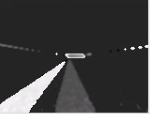Robotics URJC

Personal webpage for TFM Students.
View the Project on GitHub RoboticsLabURJC/2017-tfm-vanessa-fernandez
Week 27: Temporal difference network
Temporal difference network
I’ve tested a network that takes a gray scale difference image as the input image, but I’ve made a preprocess:
margin = 10
i1 = cv2.cvtColor(imgs[i], cv2.COLOR_BGR2GRAY)
i2 = cv2.cvtColor(imgs[i - (margin + 1)], cv2.COLOR_BGR2GRAY)
i1 = cv2.GaussianBlur(i1, (5, 5), 0)
i2 = cv2.GaussianBlur(i2, (5, 5), 0)
difference = np.zeros((i1.shape[0], i1.shape[1], 1))
difference[:, :, 0] = cv2.subtract(np.float64(i1), np.float64(i2))
mask1 = cv2.inRange(difference[:, :, 0], 15, 255)
mask2 = cv2.inRange(difference[:, :, 0], -255, -15)
mask = mask1 + mask2
difference[:, :, 0][np.where(mask == 0)] = 0
kernel = cv2.getStructuringElement(cv2.MORPH_ELLIPSE, (3, 3))
difference[:, :, 0] = cv2.morphologyEx(difference[:, :, 0], cv2.MORPH_CLOSE, kernel)
im2 = difference
if np.ptp(im2) != 0:
img_resized = 256 * (im2 - np.min(im2)) / np.ptp(im2) - 128
else:
img_resized = 256 * (im2 - np.min(im2)) / 1 - 128
I’ve used a margin of 10 images between the 2 images. The result is:

| Driving results (Temporal difference network, whole image) | ||||
| Manual | Controlnet | |||
| Circuits | Percentage | Time | Percentage | Time |
| Simple (clockwise) | 100% | 1min 35s | 35% | |
| Simple (anti-clockwise) | 100% | 1min 33s | 10% | |
| Monaco (clockwise) | 100% | 1min 15s | 3% | |
| Monaco (anti-clockwise) | 100% | 1min 15s | 3% | |
| Nurburgrin (clockwise) | 100% | 1min 02s | 8% | |
| Nurburgrin (anti-clockwise) | 100% | 1min 02s | 3% |
